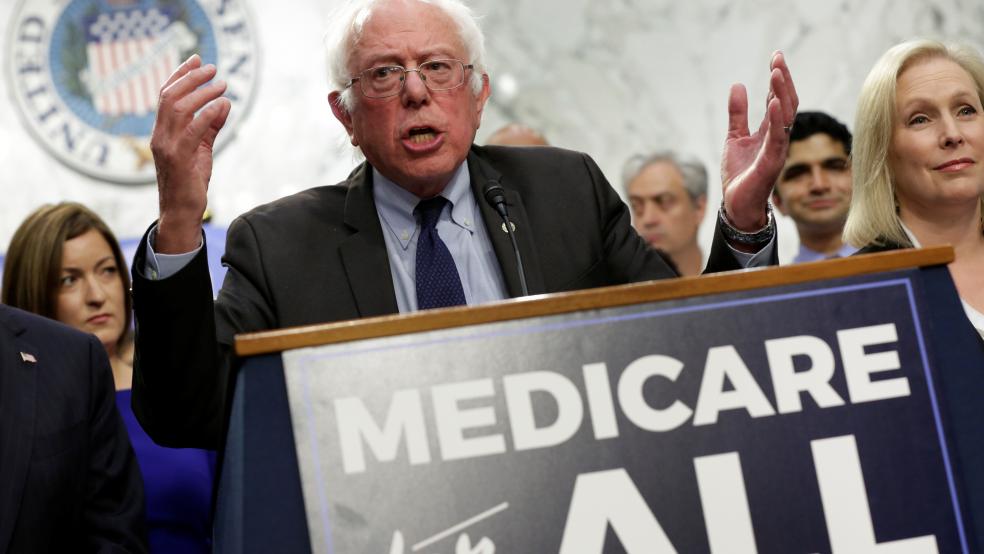A number of policy proposals associated with the “democratic socialist” agenda of Bernie Sanders and Alexandria Ocasio-Cortez are gaining ground in the Democratic Party and will likely play a role in congressional races this fall, prompting questions on both the left and the right about their cost and political viability. How much would it cost Americans to live in a country that more closely resembles the social welfare states of Western Europe, and are taxpayers willing to pay the bill?
Writing at Vox, Brian Riedl, a tax and budget expert at the conservative Manhattan Institute, examines the costs associated with some of the far left’s most popular policies, including a single-payer health care system, a jobs guarantee and fee college education. Using a host of generally favorable economic assumptions, many derived from the proposals themselves, Riedl finds that the basket of proposals would increase federal spending by $42.5 trillion over 10 years.
Here are the basics of Riedl’s analysis, all on a 10-year basis:
Current revenue and deficit baseline:
- Baseline for tax revenues: $44 trillion
- Baseline deficit: $12.4 trillion
Increases in federal spending from key democratic socialist proposals:
- Sanders’ plan for single-payer health care: $32 trillion
- Sanders’ plan for free college: $807 billion
- Sanders’ plan for 12 weeks of paid family leave: $270 billion
- Sanders’ plan to expand Social Security: $188 billion
- Ocasio-Cortez’s plan for a $15-an-hour job guarantee: $6.8 trillion
- Senate Democrats’ infrastructure plan: $1 trillion
- House Democrats’ student loan repayment plan: $1.4 trillion
- Total additional federal cost: $42.5 trillion
While the programs would offer some savings, worth as much as $8.5 trillion — a jobs guarantee would reduce antipoverty spending, for example — Riedl concludes that paying for the proposals would create a tax burden that rivals or even surpasses many European states. If all of the proposals became law, federal spending would rise to more than 40 percent of GDP, roughly twice the historical norm of between 18 percent and 22 percent. “There is no evidence that American voters will accept this level of taxation” to pay for the programs, Riedl writes.
No fan of the democratic socialist agenda, Reidl frames his analysis as a challenge to the left produce realistic plans for how they will fund the sweeping changes they propose for the America political and economic system. “If democratic socialists and their allies are serious, they must move beyond slogans and figure out how to pay for these proposals,” Riedl says, “or scale them back to plausible levels similar to last year’s tax cuts (which cost a comparatively small $1.8 trillion).”
Responses from the Left
Perhaps surprisingly, the response from experts at the progressive policy shops that tend to favor these proposals has been generally positive. Michael Linden, a fellow at the Roosevelt Institute and research director at the Hub Project, tweeted that Riedl’s analysis was “fair” while offering some additional commentary of his own.
Most significantly, Linden points out that the great majority of the cost identified by Riedl comes from the universal health care plan and the jobs guarantee. The other proposals cost less than 1.5 percent of GDP over 10 years, which is less than the cost of the GOP tax cuts, Linden says. Adding the jobs guarantee, the cost rises to 4.2 percent of GDP — which would require “roughly Canada-level taxation levels (which still would put the U.S. in the bottom 3rd of OECD countries),” Linden says.
The real challenge, then, is how to pay for the health care proposal, which Linden says is a “totally fair question.” In the end, Riedl is “not wrong that the left has proposed some big and bold ideas! He's also not wrong that there are details that still remain to be ironed out,” Linden says.
Richard Phillips, a senior policy analyst at the liberal Institute on Taxation and Economic Policy, pushes back a bit against Riedl’s analysis of the single-payer health care system, arguing that Sanders’ estimate for the cost was closer to $14 trillion rather than $30 trillion, and that the price tag could be reduced by making the program less generous and more in line with other national systems. But overall, Phillips acknowledges that the democratic socialist proposals represent a serious fiscal and political challenge: “The idea that Americans will not support high European-level taxes has proven up to this point in history to be true, but the whole point of Democratic Socialist movement is to reopen this discussion and create the potential for bigger picture expansions.”
The bottom line: There are huge, multi-trillion-dollar questions that still need to be hashed out about single-payer health care and other proposals from the left. At the same time, Riedl’s analysis underscores the fact that these proposals are at the heart of today’s policy debates. Aside from GOP tax cuts and Trump’s controversial trade and immigration plans, Democrats appear to have seized the momentum when it comes to setting a policy agenda.




